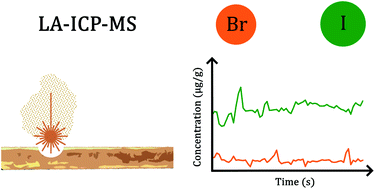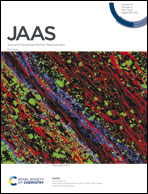Laser ablation-ICP-mass spectrometry for determination of the concentrations and spatial distributions of bromine and iodine in human hair†
Abstract
Laser ablation-inductively coupled plasma-mass spectrometry (LA-ICP-MS) was applied for the determination of Br and I in hair strands of human individuals under treatment with synthetic thyroid hormones. Quantification relied on the use of Br- and I-spiked human hair strands prepared in-house as matrix-matched external calibration standards. The results obtained via LA-ICP-MS agreed with the corresponding Br and I concentrations as determined via pneumatic nebulization-ICP-MS after digestion via microwave-induced combustion. The spatial distributions of Br and I in the spiked hair standards were evaluated by spatially resolved LA-ICP-MS analysis and a homogeneous distribution was established upon scanning longitudinally along the hair strands and across the cross-section. Twenty-five human hair strands from volunteers were analyzed by LA-ICP-MS (7 individuals with hypothyroidism under treatment with synthetic thyroid hormones and 18 individuals considered healthy), and those from subjects under treatment with synthetic thyroid hormones presented a higher I concentration than those from subjects considered healthy. Limits of detection were 0.36 μg g−1 for Br and 0.14 μg g−1 for I, allowing trace level determination in human hair.

- This article is part of the themed collections: ENQA - 20th Brazilian Meeting on Analytical Chemistry, Community Leaders: Ramon Barnes and JAAS HOT Articles 2022


 Please wait while we load your content...
Please wait while we load your content...